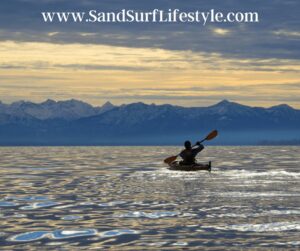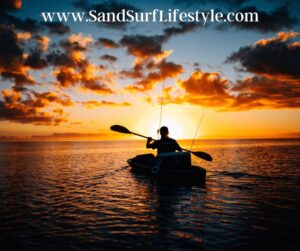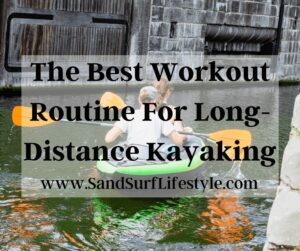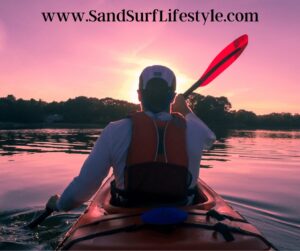The Best Workout Routine For Long-Distance Kayaking
Do you long to feel the crisp breeze rolling across the water? Are adventure and nature two things that you find deeply enjoyable? Is kayaking your passion? Are you ready to take your kayaking abilities to the next level? Long-distance kayaking can seem like a formidable task, but with the proper training, it’s a wholly attainable goal.
What is the best workout routine to prepare for long-distance kayaking?
The best workout routine for long-distance kayaking is:
- Planks
- Dumbbell squat and press
- Cable machine woodchop
- Bent-over row
- Biceps curl
- Kettlebell Swings
 Preparing for long-distance kayaking will involve a routine that will:
Preparing for long-distance kayaking will involve a routine that will:
- Increase your strength
- Increase your muscle endurance
- Improve your balance
- Increase your aerobic capacity (cardio endurance)
If you’re looking to increase your time on the water, then this article has been written just for you! So, let’s get to paddling (amongst other things!).
I can wield a mean paddle. That’s all I need, right? To just paddle more?
Of course, increasing the number of times you can hit the water or bumping up the duration of your kayaking journeys is truly the best means to improving your on-the-water performance. With that said, unless you’re making a paycheck by paddling (you’re a pro), you’ll likely need to incorporate a few workouts on dry land to ensure you’re checking off all the boxes to get you to the finish line.
A well-rounded, detailed kayak training program can take you from short jaunts across the lake to day-long journeys and keep those common kayaking injuries at bay. Not only will you increase your ability, but you’ll find that with a lower level of fatigue, the journey is a lot more fun!
Strong like Hulk….well, sort of!
Strength training can have a drastic impact on your kayak performance. Not only will you build strength but your muscle endurance, as well. Though you might be inclined to think that you really only need to focus on increasing your upper body strength to improve your kayaking abilities, neglecting the posterior chain of the hips, glutes (your booty), upper legs, and core will leave you anchored at the dock.
A few great exercises you can incorporate into your current fitness routine to get your paddles rowing are:
Exercise
- Muscles worked
- Reps
- How to execute
Planks
Core, arms, lower back, shoulders, glutes, and thighs
As long as possible
Lay on your stomach, with your elbows directly underneath the shoulders, forearms flat on the ground, and your feet hip-width apart. Tuck the toes under and lift yourself off the ground, while maintaining a straight line throughout the body. Squeeze the quads and glutes and engage your core, as if you were trying to pull your belly button toward the ceiling, which will help keep your hips level.
Keep the back straight, with your head and neck in a neutral position. Breathe (because oxygen is kind of important) and hold as long as you can.
Dumbbell squat and press
Glutes, quads, upper body, core
12-15 reps
Stand with your feet hip-width apart, with a dumbbell in each hand. The dumbbells should be at shoulder height, by the ears, with the elbows bent. Lower yourself into a squat, with thighs nearly parallel to the floor. Keep the knees in line with the toes. As you push your body up and return to a standing position, continue the motion. Press the dumbbells above your head, bringing the biceps up to the ears. Return to the starting position and repeat.
Cable machine woodchop
Abdominals, obliques, back, shoulders, glutes

12-15 reps each side
Stand with your feet apart, grasp the cable handle with both hands, and hold it above one shoulder and at head height. Position yourself side-on, so that the movement can travel downward and across the body. Engage the core and keep the back straight, rotate your torso to the side and pull the handle diagonally across the body until it reaches the opposite thigh. Your hips and knees may rotate slightly, and you can also rise on your toes as you twist and pull. You must keep the arms straight throughout the motion. Allow the cable resistance to move the handle back to the starting position and repeat.
Bent-over row
Back, glutes, legs, upper body, core
10-12 reps
Start with feet shoulder-width apart and grab the barbell with both hands, positioning the palms slightly wider than shoulder-width apart. Keep the arms straight and let the weight hang. Bend your knees slightly and lean forward at the hips until your torso is nearly parallel to the ground. Keep the back straight. Engage the core muscles, taking the weight, and squeeze your shoulder blades together, driving the elbows behind the body and rowing the barbell up and toward your torso. Once it reaches the body, pause before lowering it back to the starting position in a controlled motion – and repeat.
Biceps curl
Biceps
10-12 reps
Begin standing tall with your feet about hip-width apart. Keep your abdominal muscles engaged. Hold one dumbbell in each hand. Let your arms relax down at the sides of your body with palms facing forward.
Keeping your upper arms stable and shoulders relaxed, bend at the elbow and lift the weights so that the dumbbells approach your shoulders. Your elbows should stay tucked in close to your ribs. Exhale while lifting. Lower the weights to the starting position.
Wetsuit vs Drysuit: Which is Better for Kayaking? Find out here.
Kettlebell Swings
Core, glutes, thighs, hamstrings, back, shoulders
10-15 reps
Start with feet shoulder-width apart and the kettlebell sitting in front of you on the ground.
Bending primarily at the hips, but with a slight bend in the knees, grasp the kettlebell with both hands, palms facing the body. Lift it and let it swing back between your legs to create momentum. Drive the hips forward and send the kettlebell swinging upward from the quads, no higher than your shoulders. Contract the core and squeeze the glutes as you reach the top of the movement. Allow the kettlebell to descend back through your legs. Its weight should do most of the work. Keep the core engaged and control the downward swing. Repeat.
Strength training is not meant to be a form of torture. Sadly, it’s also true that the old adage of “no pain, no gain” stands true. You won’t gain strength and muscle endurance without feeling just a tad bit uncomfortable. Remember, there’s a method to the madness!
I got the strong part….now what?
You’re stronger and faster. That’s awesome! But, if you can’t stay balanced in your kayak, what’s the point?? Maintaining your balance while kayaking is a key component to staying on the water and not in it! Here’s a great exercise you can do to improve your balance at sea (or on land, if you’re prone to tipping over occasionally like I am!):
- Pilates Ball and C-Leans:
- Begin by sitting on top of a firm Pilates/swiss ball with a paddle in hand.
- Start the exercise with both feet about shoulder-width apart or wider if needed for balance.
- Place the paddle across the top chest just above the collar bone.
- Place the paddle in a high brace position keeping the elbows tucked close to the body.
- On your bracing side (where the paddle meets the water), make the letter C with your body. Raise the hip by using the oblique muscles of the abs. Try to lay your head over on the shoulder.
- Hold this position for five seconds.
 Swap sides by switching your high brace and raising the hip.
Swap sides by switching your high brace and raising the hip.- While changing sides, lower your shoulder and lay your head over.
- Hold this position for five seconds and then go back to the other side.
- Repeat 10-12 times making sure to hold the C-lean for five seconds on each turn.
Don’t hesitate to take in a few yoga or Pilates classes down at your local gym. Both forms of exercise can really increase your overall flexibility, balance, and zen level!
I’m strong, I’m stable….did you say something about cardio?
Increasing your strength, muscle endurance, and balance is absolutely useless if your poor little heart and lungs can’t keep up. That’s where the ol’ cardio (is hard-io) comes into play. There are multiple benefits to increasing your cardiac capacity through aerobic exercise, including reduced risk of injury, weight loss, and increased endurance.
It is recommended that you include at least two days of cardiovascular aerobic training to ensure that you are reaching your set goal of long-distance paddling (you know, without gasping for air and falling out of your kayak).
Honestly, there’s no go-to, set-in-stone, aerobic program that fits everyone. You could add a run in twice a week, laps at the local pool, skiing, biking, Zumba, or a high-intensity aerobics class taught at your local gym (likely by a guy in some sparkly spandex). Regardless of what you choose as your form of aerobic activity, make certain that it is something that:
a) You enjoy; and
b) Challenges you!
Strength, endurance, stability, keep breathing….how do I do it all?
Ideally, you should start training six to eight weeks before you’ll be making the trek of a lifetime. One simple schedule you can follow regarding your strength/muscle endurance training and aerobic (cardio) training is:
● 3 nonconsecutive days of strength training (Monday, Wednesday, Friday)
● 2 nonconsecutive days of cardio sessions (Tuesday, Saturday)
● 2 nonconsecutive active rest days (not ‘potato on couch’ rest) (Thursday, Sunday)
Get out there and get to paddling!
Amidst all that has been thrown at you, don’t forget to drop your kayak in the water and enjoy yourself from time to time. Remember, the finish line will be there when you arrive!
Related Questions
1. What about stretching?
Stretching is fundamental for all activities! After a day of paddling, your body can really feel it. A few simple stretches can make a world of difference in your recovery period, alignment, and overall flexibility.

Please note: This blog post is for educational purposes only and does not constitute legal or medical advice. Please consult a legal expert or medical professional to address your specific needs.


 Swap sides by switching your high brace and raising the hip.
Swap sides by switching your high brace and raising the hip.